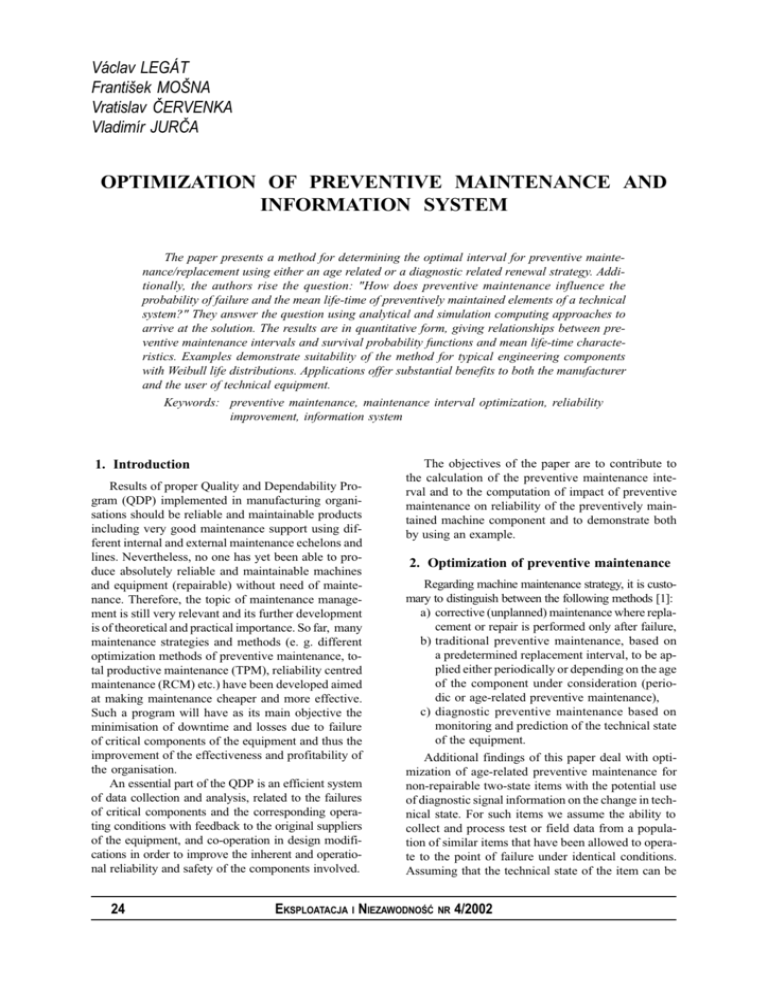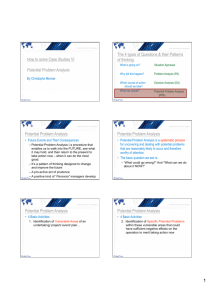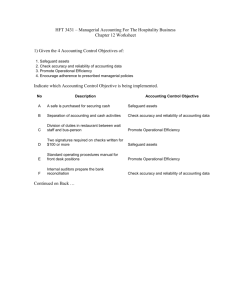optimization of preventive maintenance and information system
advertisement

Václav LEGÁT
Frantiek MONA
Vratislav ÈERVENKA
Vladimír JURÈA
OPTIMIZATION OF PREVENTIVE MAINTENANCE AND
INFORMATION SYSTEM
The paper presents a method for determining the optimal interval for preventive maintenance/replacement using either an age related or a diagnostic related renewal strategy. Additionally, the authors rise the question: "How does preventive maintenance influence the
probability of failure and the mean life-time of preventively maintained elements of a technical
system?" They answer the question using analytical and simulation computing approaches to
arrive at the solution. The results are in quantitative form, giving relationships between preventive maintenance intervals and survival probability functions and mean life-time characteristics. Examples demonstrate suitability of the method for typical engineering components
with Weibull life distributions. Applications offer substantial benefits to both the manufacturer
and the user of technical equipment.
Keywords: preventive maintenance, maintenance interval optimization, reliability
improvement, information system
1. Introduction
Results of proper Quality and Dependability Program (QDP) implemented in manufacturing organisations should be reliable and maintainable products
including very good maintenance support using different internal and external maintenance echelons and
lines. Nevertheless, no one has yet been able to produce absolutely reliable and maintainable machines
and equipment (repairable) without need of maintenance. Therefore, the topic of maintenance management is still very relevant and its further development
is of theoretical and practical importance. So far, many
maintenance strategies and methods (e. g. different
optimization methods of preventive maintenance, total productive maintenance (TPM), reliability centred
maintenance (RCM) etc.) have been developed aimed
at making maintenance cheaper and more effective.
Such a program will have as its main objective the
minimisation of downtime and losses due to failure
of critical components of the equipment and thus the
improvement of the effectiveness and profitability of
the organisation.
An essential part of the QDP is an efficient system
of data collection and analysis, related to the failures
of critical components and the corresponding operating conditions with feedback to the original suppliers
of the equipment, and co-operation in design modifications in order to improve the inherent and operational reliability and safety of the components involved.
24
The objectives of the paper are to contribute to
the calculation of the preventive maintenance interval and to the computation of impact of preventive
maintenance on reliability of the preventively maintained machine component and to demonstrate both
by using an example.
2. Optimization of preventive maintenance
Regarding machine maintenance strategy, it is customary to distinguish between the following methods [1]:
a) corrective (unplanned) maintenance where replacement or repair is performed only after failure,
b) traditional preventive maintenance, based on
a predetermined replacement interval, to be applied either periodically or depending on the age
of the component under consideration (periodic or age-related preventive maintenance),
c) diagnostic preventive maintenance based on
monitoring and prediction of the technical state
of the equipment.
Additional findings of this paper deal with optimization of age-related preventive maintenance for
non-repairable two-state items with the potential use
of diagnostic signal information on the change in technical state. For such items we assume the ability to
collect and process test or field data from a population of similar items that have been allowed to operate to the point of failure under identical conditions.
Assuming that the technical state of the item can be
EKSPLOATACJA I NIEZAWODNOÆ NR 4/2002
NAUKA I TECHNIKA
measured by means of the change in level of a diagnostic signal S (e. g. change in noise level, in critical
dimension), the item life at failure can be graphically
represented as in Fig. 1. Failure of item i is characte-
• if a high value of tp is selected, the costs of pre-
ventive replacement will go down but the costs
due to failure occurrence will rise.
The optimal value of tp can be calculated such that
the mean costs per unit age replacement cycle time
c(tp) are minimised, where
u( t p ) =
c1 F( t p ) + co R( t p )
t( t p )
(1)
tp
and
t( t p ) = ∫ R(t)dt
(2)
0
Minimum of c(tp) is
C pr + L f F (t po )
Fig. 1. Relationship between diagnostic signal S and
operating time t
c(t po ) =
rised by lifetime t1 and physical state S1. Clearly, both
time to failure and change in diagnostic parameter
are random variables which have probability density
functions f1(t), f2(S), distribution functions F1(t), F2(S),
survival functions R1(t), R2(S) and failure rates λ1(t),
λ2(S). The parameters of the appropriate model for
these functions can be estimated from empirical data.
When a predetermined replacement interval based on
age or diagnostic replacement strategies is used (as
denoted by tp or Sp) the replacement will take place
either immediately after failure or after the elapsed
time interval tp (or change in diagnostic parameter Sp),
whichever occurs first.
A further assumption made is that replaced items
are considered to be as-good-as-new ones.
We now consider the costs Ccr associated with one
corrective replacement action (after failure) and the
analogous costs Cpr associated with unit preventive
age-related replacement action, where Ccr>Cpr. The
difference Ccr-Cpr may be regarded as the losses Lf
attributable to a failure.
On the basis of information on the models of time
(or change in diagnostic signal) to failure and on costs, the optimal values of tp=tpo (or Sp=Spo) which minimise the mean unit costs of operation and maintenance during the equipments useful life can be
calculated.
Heuristic considerations indicate that the selection of a particular value for the age related replacement interval tp (or Sp) has the following effects:
where tpo is an optimal interval of preventive maintenance and λ(tpo) is failure rate at tpo, cin(tp)=Lfλ(tp) are
instantaneous (marginal) unit costs, Lf=Ccr-Cpr are
losses due to replacement after failure.
Equation (1) can be modified for the case where
the technical state of the item S is monitored (preventive diagnostic replacement - PDR) and where the optimal value Spo of the diagnostic signal at which a replacement should be made is determined from the
equation
• if a small value of tp is selected, there will be
smaller costs CcrF(tp) due to failure occurrences
and higher costs Cpr×R(tp) due to preventive replacement,
t (t po )
= L f λ (t po ) = cin (t po )
c1 F( S p ) + c0 R( S p )
u( S p ) =
t( S p )
(3)
+ u pd
(4)
where cpd denotes unit costs of monitoring during
t (Sp), the mean time to reach the state Sp, which can
be determined from empirical data using the formula
t( S p ) =
1
n
m( S p )
n-m( S p )
i=1
j=1
∑ ti( S p ) + ∑
t j ( S p ) (5)
and where ti(Sp) denotes the operating time of the i-th
item surviving at the level Sp, tj(Sp) denotes the time
to failure of the j-th item which failed before reaching
the state Sp, m(Sp) is the number of items reaching
state Sp without failure and n is the total number of
items in the investigated population.
The function (5) can be approximated by a regression function. A typical case of the relationship between t(Sp) and Sp is shown in Fig. 2. The optimal
value of the state parameter Spo (preventive replacement interval) can be found either graphically or by
calculation. The graphical solution is shown in Fig. 3
EKSPLOATACJA I NIEZAWODNOÆ NR 4/2002
25
NAUKA I TECHNIKA
Fig. 2. Principle of determining the optimal mean
value of the time interval t (Spo ) for PDR
with the optimal mean time t(Spo) shown in Fig. 2.
The possibility of deriving the analytical solution depends
on the concrete type of the functions F(Sp) and t(Sp).
3. Calculation of mean life and survival function of age-related preventively maintained
components
Let us monitor a series of components that underwent preventive maintenance (were replaced) after
time interval tp using a new component with the same
reliability properties. Component reliability can be improved during operation by preventive replacement
at time tp. Durability of k-th component is described
by random variable Xk with the same density function
f and distribution function F. We consider random variables X1, X2,
as the independent quantities. The
preventive replacement of a component is not considered as a failure. Let us denote a random variable
that describes the life of line of age-related, preventively replaced components T. Further we will be able
to derive [2]:
a) distribution function
{
FT(x) =
F(x)
on(0; tp)
F(tp) + qF(x - tp)
on (tp; 2tp)
F(tp) + qF(tp) + q2F(x - 2tp) on (2tp; 3tp)
..............................
(6)
b) density function fT through differentiation of FT
{
fT(x) =
f(x)
qf(x - tp)
q2f(x - 2tp)
..............................
on(0; tp)
on (tp; 2tp)
on (2tp; 3tp)
(7)
1
ET =
p
tp
∫
∫
R( x)dx = 0
tp
R( x)dx
1 − R (t p )
0
(8)
and for the Weibull distribution function with parameters α a β we can write
tp
ET =
∫0
t
exp(−( )α )dt
β
1 − exp(−(
tp α
) )
β
(9)
where R(x) = 1 - F(x) is survival function.
For solution of equation (9) it is possible to use
a numerical method, e. g. using EXCEL software.
We can obtain input data using a computer supported information system collecting following information on:
• costs associated with one preventive age-related
replacement action Cpr,
• costs associated with one corrective replacement
action (after failure) Ccr,
• losses attributable to a failure Lf,
• density function f(x),
• distribution function F(x),
• survival function R(x),
• failure rate function l(x).
The all reliability functions are based on a time to
failure monitoring and collection and before mentioned calculation.
4. Example from practice
For mean value ET of the life of age-related preventively replaced components at time tp we obtain
following equation [2]:
26
Fig. 3. Principle of determining the diagnostic signal
Spo for PDR
We have been monitoring the life of two rubber
body strips of a cylindrical feeder beater from a machine for manufacturing paper sacks see Fig. 4.
During operation the rubber body strips are wearing
EKSPLOATACJA I NIEZAWODNOÆ NR 4/2002
NAUKA I TECHNIKA
data collection and information system provides following data on reliability (durability) see Tab. 1 and
maintenance cost data see Tab. 2 [3].
Solution:
Using input reliability data from Tab. 1 and software STATGRAPHICS we obtained mean time to
failure (MTTF), standard deviation (SD) and parameters α and β of the Weibull distribution function
see Tab. 3. Substituting obtained input data into equation (3) and using EXCEL we can calculate optimal
age-related replacement (maintenance) interval tpo see
Tab. 4. For a better illustration, the dependencies c(tp)
and cin(tp) are plotted using EXCEL see Fig. 5.
Now we use EXCEL to compute mean life ET
(MTTRT) of the components that have undergone preventive maintenance after the optimal interval tpo=121
hours according to the modified equation (12) using
numerical method of R(t) integration
Fig. 4. Scheme of cylindrical feeder beater
out and loosing feeder function and capability causing a failure of the whole production line. The task
for a maintenance manager is to implement preventive maintenance, calculate the optimal interval of agerelated preventive maintenance, mean time and survival probability function of the rubber body strips
that underwent preventive maintenance and compare
preventive maintenance with corrective maintenance
results for the same component. Implemented input
∫
ET = 0
t po
R(t)dt
1 − R(t po)
=
120,908
= 37444hours.
1 − 0,996771
(14)
Tab. 1. Failure frequency of rubber body strips within particular operation time intervals
Interval mean ti (hours)
Interval (hours)
Failure frequency
120
0 - 239
1
360
240 - 479
2
600
480 - 719
4
840
720 - 959
6
1080
960 – 1199
1
Tab. 2. Maintenance cost data
Costs/Losses
Costs of preventive
maintenance Cpr (Kè)
Calculation
Labour consumption * (Wages + Overhead) + Material costs =
0,3*(90+270)+500 =
Costs of corrective
maintenance Ccm (Kè)
(Labour consumption + Logistic delay) * (Wages + Overhead) +
Material costs + (Downtime * Hour losses) = (0,3+0,5)*(90+270)
+ 500 + (0,3+0,5) *60000 =
Costs of corrective maintenance – Costs of preventive
maintenance = 48788 – 608 =
Production losses due to
failure and following
downtime Lf (Kè)
Results (Kè)
608
48788
48180
Tab. 3. Parameters of the Weibull distribution function, MTTF and SD
MTTF (Hours)
637
Shape parameter α
3,24518
Standard deviation (SD)
236,903
Scale parameter β
708,219
Tab. 4. Dependence of unit costs and instantaneous (marginal) unit costs on replacement interval
tp
u(tp)
cin(tp)
25
14,0
0,1
50
7,2
0,6
75
5,1
1,4
100
4,3
2,7
125
4,2
4,5
150
4,4
6,8
175
4,9
9,6
200
5,7
12,9
225
6,7
16,8
250
7,9
21,3
275
9,3
26,4
300
10,9
32,1
325
12,7
38,4
350 1400
14,6 76,4
45,4 1115
Tab. 5. Survival function R(t) of maintained machine components after failure and RT(t) of the age-related preventive maintained machine components
t
RT(t)
Rt(t)
0
1,000
1,000
200
0,996
0,983
400
0,990
0,853
600
0,984
0,554
800
0,980
0,224
1000
0,974
0,046
1200
0,969
0,004
10000
0,766
0,000
EKSPLOATACJA I NIEZAWODNOÆ NR 4/2002
20000
0,586
0,000
30000
0,449
0,000
40000
0,344
0,000
50000
0,263
0,000
27
NAUKA I TECHNIKA
Finally, using a modified equation (8), we calculate the failure probability FT(t) and survival function
RT(t) of the components that underwent age-related
preventive maintenance
FT(t) = 1 - [R(tpo)]n × R(t-ntpo) on (ntpo; (n+1)tpo) (15)
and
RT(t) = [R(tpo)]n × R(t-ntpo) on (ntpo; (n+1)tpo)
(16)
Numerical solution and results of F(t) and R(t) (for
the Weibull distribution function with parameters
a=3,24518 and b=708,219 and for tpo=121 hours) are
clear from Tab. 5. For a better illustration of the agerelated preventive maintenance effectiveness the dependencies R(t) and RT(t) are plotted using software EXCEL
see Fig. 6.
Fig. 5. Dependencies of cin (tp) and c (tp) on tp
5. Conclusions
The paper presents general methods of calculating the optimal interval for preventive maintenance/
replacement using either an age-related or diagnostic-related renewal strategy for an infinite time horizon. Further, authors deduced equations for mean life
and probability survival function of age-related preventively maintained/replaced machine parts (components).
The example shows an application of the proposed mathematical model on an actual machine component (rubber strips of a cylindrical feeder beater).
When we replace the strips after failure, the
MTTF=637 hours and production losses due to the
failure, following down time Lf=48180 Kè and unit
costs of replacement and operating u(tp=1400)=76,4
Kè/hour - see Tabs. 2, 3 and 4. When we introduce
age-related preventive replacement of the components, the MTTF increases to MTTFT=37444 hours
executing preventive maintenance (replacement) in
optimal interval tpo=121 hours and unit costs of replacement and operating u(tpo=121) decreases to 4,17 Kè/
hour - see Equation (14) and Fig. 5. The probability
of survival of the age-related preventive replaced component increases (e. g. for t=600 hours) from
R(600)=0,554 (replacement after failure) to
RT(600)=0,984 (age-related preventive replacement)
see Tab. 5 and Fig. 6.
The benefit of the proposed mathematical model
is not only the ability to calculate the optimal interval
of age-related preventive and diagnostic maintenance but also to provide quantitative proof that preventive maintenance increases operational reliability of
machine parts.
Fig. 6. Survival function R(t) and RT(t) versus operating time
28
EKSPLOATACJA I NIEZAWODNOÆ NR 4/2002
NAUKA I TECHNIKA
6. References
[1] LEGÁT, V., ALUDOVÁ, A., ÈERVENKA, V., JURÈA, V.: Contribution to optimization of preventive
replacement. In: Reliability Engineering and System Safety 51, 1996 Elsevier Science Limited, s. 259 - 266.
[2] LEGÁT, V., MONA, F., ÈERVENKA, V., JURÈA, V.: Preventive maintenance a tool for operational
reliability improvement. In: Proceedings of the 16th International Maintenance Conference EUROMAINTENANCE 2002, 3rd-5rd of June 2002, Helsinki, p. 53-61.
[3] PELC, L. Návrh technologie údrby v AssiDomän Sepap Sack a.s. tìtí (Proposal of maintenance technology
at AssiDomän Sepap Sack a.s. tìtí). [Diploma work]. CUA TF, Prague 2001.
**********
The paper was prepared with support from the Ministry of Education, Youth and Sports of Czech Republic in
keeping with the terms of research project J03/98:413100016.
**********
Prof. Ing. Václav Legát, DrSc.
RNDr. Frantiek Mona, Ph.D.
Ing. Vratislav Èervenka,
Doc. Ing. Vladimír Jurèa, CSc.
Czech University of Agriculture
Technical Faculty
165 21 Prague 6 Suchdol
Czech Republic
tel.: 00420-2-2438 3268
fax.: 00420-2-2092 1361
e-mail: legat@tf.czu.cz
EKSPLOATACJA I NIEZAWODNOÆ NR 4/2002
29






